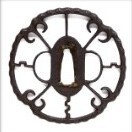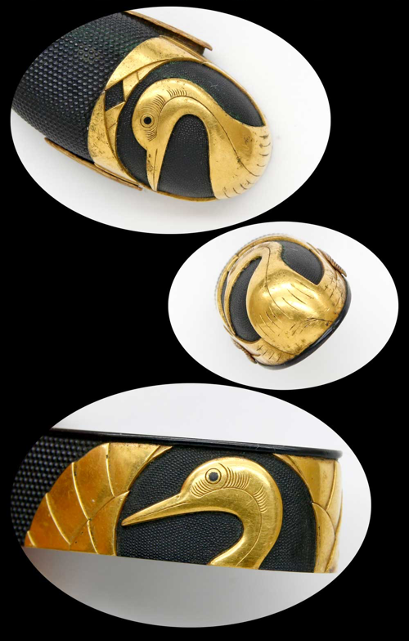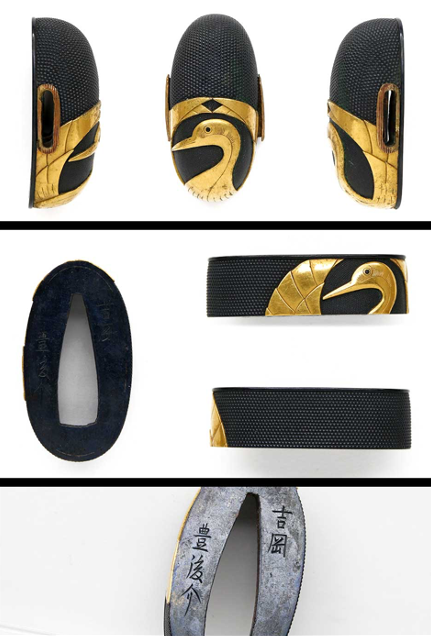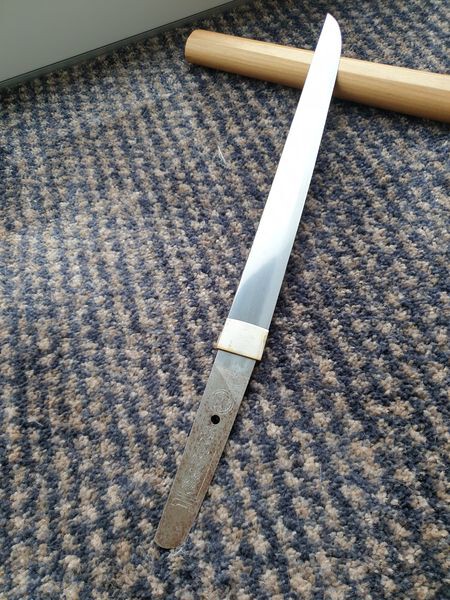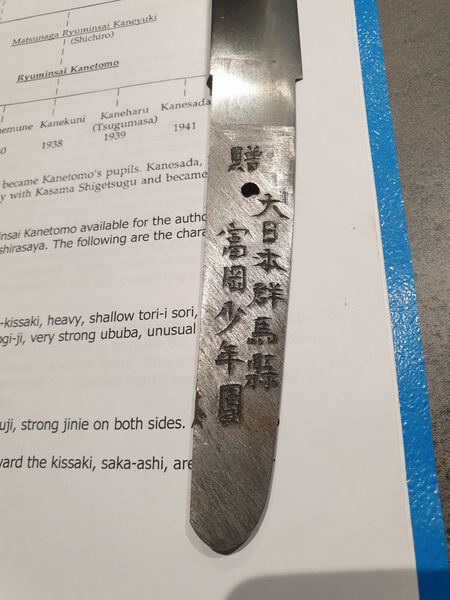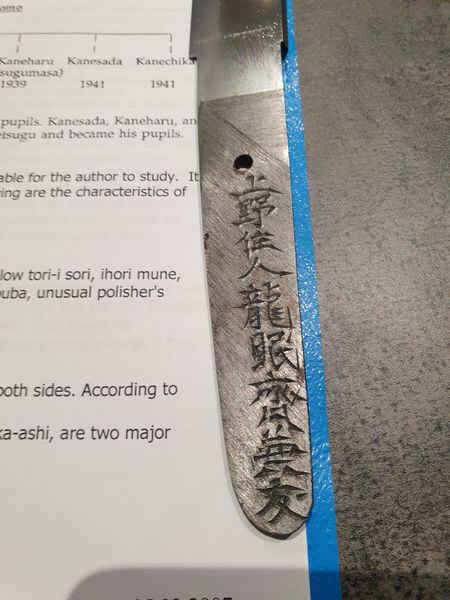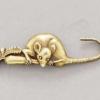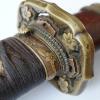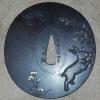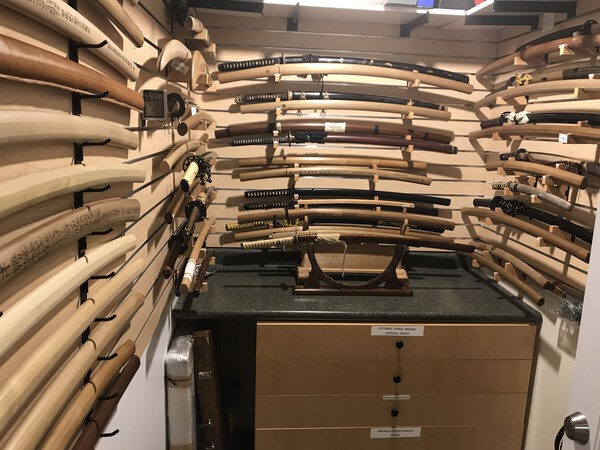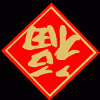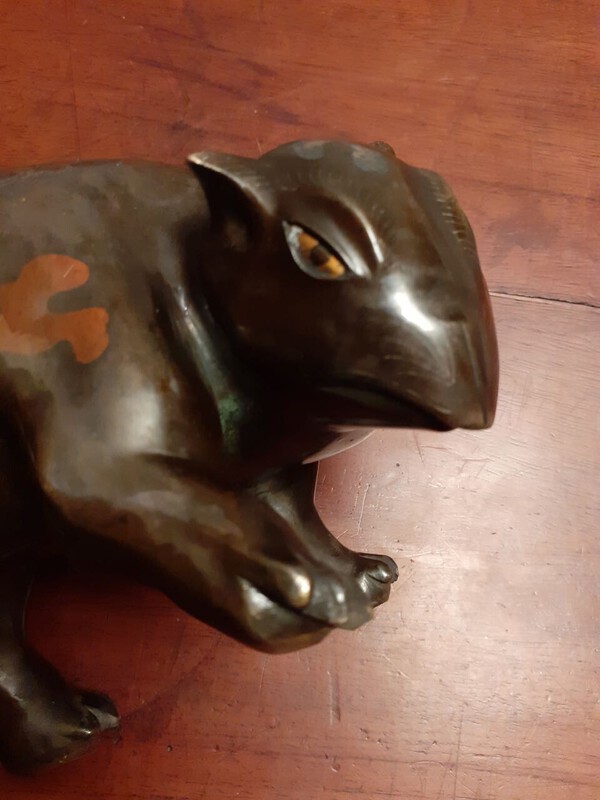Leaderboard
Popular Content
Showing content with the highest reputation on 04/05/2021 in all areas
-
Hello, I have completed the koshirae project. The first time I was wrapping a curved and rounded saya - naginata shape. It was an interesting experience. Working with samegawa is done after it gets wet and you need to know the drying and shrinking time of the skin to do this. What was new to me in this project were: - new shape of the seppa rim, - leveling the braid on the sides of the tsuka - jabaraito katatemaki, so that the attached tsukaito strips on tsuka ura are not visible - tsunagi - first job. Saya and tsuka was made of Ho wood, tsunagi - alder wood. I still need more practice with wood work, have to buy more tools Thanks for watching. Best11 points
-
5 points
-
The most unusual we have ever seen!!!! A high class long Gendai Tanto, used as a mobile shrine..... The Mon side has a memorial tablet known as "eihai". It appears that the content was written by a Buddist monk and is virtually a chant taking elements from the monks name and temple, plus the posthumous name given to the deceased that must also include one Kanji from his real name,( in this case"tetsu"). This posthumous name is known as a "kaimyo". The date is the death of the officer. The other side has the rank and the real name of the dead officer, with a request, that his spirit resides in this blade. "The swordsmith is not mentioned,but presumably it was made after the date specified,according to Mr. Han Bing Siong sand and Ogasawara san's opinion, cleary made by Hori Toshihide. The Mon represents the dead mans familie. It is that of the Nakamura, Mizuno and Okudaira familie....... The tablet inscriptions read as follows.: "CHUSEIIN" (Name of the monks temple) KOYO JUNDO ( spiritual name implying the deceased was a matyr) "TETSUSHIN" (posthumous name) "KOJI" (Buddist layman) "SENSHI" (death in action. Showa 10 8 nen 9 gatsu 2 10 1 Hi (21.day of the 9. month in the 18. year of showa i.e. 21.september 1943. Rikugun (army) "SHUKEI" ( Intendance, accountant) "TAII" (1st Leutnant Kubota) "TESTSUO"( officers name) "RYU" (remain in) "KON" (soul spirit) "TO" sword, ie. Tanto. Army Intendance 1. Leutnant Kubota Testsuo, his spirit, soul, remain in this blade........5 points
-
Hiya Juan, this is why I advocate that these swords be referred to as Okashi-to (loaned swords)rather than Satsuma rebellion pieces. There is already a category of Satsuma style swords, and generally fine swords they are. Why the other type got given the name is one of those bits of history, along with Type 3's, Naval Landing Swords, and Kamikaze daggers..... and probably from the same date and the same reasons.....Post War dealers! If you are unfamiliar with the term Okashi-to it refers to swords held in armouries and issued out to lower class Samurai or Ashigaru as and when needed. There are other threads here covering the subject in more detail.5 points
-
3 points
-
Here is quick translation of the picture. I should have have all the smiths correctly but there might be some errors on the romanization of lamination styles. 高橋俊光 - Takahashi Toshimitsu / 三善長道 - Miyoshi Nagamichi / 秋広 - Akihiro / 折り返し三枚 – Orikaeshi Sanmai / 八枚合わせ - Hachimai Awase / 三枚合わせ – Sanmai Awase / 割り鋼 – Wari ? (I believe this is Wariha tetsu) / 無垢 (丸鍛之) – Muku (Maru kitae) 肥前忠吉 – Hizen Tadayoshi / 備前祐永 – Bizen Sukenaga / 信国 – Nobukuni / 四方詰め – Shihozume / 九枚合わせ – Kyūmai Awase / 五枚合わせ – Gomai Awase / まくり – Makuri 金剛兵衛盛高 – Kongōbyoe Moritaka / 備前景光 – Bizen Kagemitsu / 備前春光 – Bizen Harumitsu / 関兼先 – Seki Kanesaki / 本三枚 – Honsanmai / 七枚合わせ – Nanamai Awase / 甲伏せ (かぶせ) - Kōbuse3 points
-
2 points
-
Thank you Dave, that term is a great deal less confusing. To be honest, I’m fond of Satsuma Koshirae, so I was a bit disappointed when I clicked and found out the Satsuma mounts mentioned in this thread referred to jury-rigged fittings. And Micah, seeing as how the blade is so badly out of polish, maybe it wouldn’t hurt to use high quality uchiko here? It might make the hamon a bit more visible. Seeing as how there’s no signature and the nakago has been filed clean, that might be the only way to get more information. For what it’s worth I don’t think it’s a muromachi katate-uchi: the examples I’ve seen have a wider mihaba and they have sakisori.1 point
-
I'm not sure who you think called you a liar here, but it certainly wasn't me. I was just pointing out what appeared to be some confusion in your interpretation of the punched date. I know nothing about blades, but yours does look gorgeous to me.1 point
-
Hi Chris, Keep looking on NMB For Sale section. Most members here are ok. The ones that are not, tend to shoot themselves in the foot pretty early on. Look for number of Posts as an indicator. Good Luck !!1 point
-
Very tasteful and good craftsmanship!1 point
-
1 point
-
1 point
-
Great job! It looks beautiful. Thank you for sharing MikeR1 point
-
please enjoy this, two pieces from my extensive long term collection!!! Happy easter....1 point
-
1 point
-
I am more than impressed with your work. I am quite sure we will see you in the NBSK competitions in the near future.1 point
-
Very beautiful. Wish I had that kind of skills.1 point
-
A Sa blade needs a long kissaki for me to want it. That said, both are weak for Sa.1 point
-
Hello Micah, I’m sort of confused as to why you call it a satsuma sword. If you mean the koshirae, it doesn’t look like this has the two holes you would expect from a Satsuma tsuba. It doesn’t look much like a lot of the very fine examples of Satsuma koshirae out there https://yuhindo.com/ishiguro-masayoshi-koshirae/ Did you mean you think the mounts are from the Satsuma Rebellion and that is why they appear crude? If you mean the blade, the following traits are what you could expect from Satsuma work but your sword is too out of polish for such things to be discernible. As friendly advice from one beginner to another, I’d like to say that you’re better off by starting with swords that are in decent polish. It takes collectors with a lot more experience than either of us to size up swords in poor condition and guess on if they’re worth a restoration. Better to hang on to your money for stuff you’ll like more I think.1 point
-
1 point
-
No need to look at the mei, the blade doesn't show the quality desired to any name. As long as you like it that counts.1 point
-
1 point
-
I would think like Kirill above that most likely it would be some unknown Muromachi period Yoshikuni, or gimei signature that was added a long time ago. As you are in Georgia (I assume in the US Georgia?), you have NTHK shinsa at some US shows. So you might want to wait for a chance to put it through NTHK shinsa in the US. Unfortunately economically I would not see sending this to Japan for shinsa as cost efficient option. Then again should we always do everything from monetary view? Personally I would run this through NTHK just for fun too to get their opinion, and also if you have local sword clubs, organizations etc. I would also ask opinions from their members. For reference here is how Yoshikuni looks in Onizuka Yoshikuni signatures. Unfortunately I don't have reference examples of the lesser known late Muromachi Yoshikuni smiths.1 point
-
1 point
-
As important as the mei is, it's just one of many things that must be considered when determining if the blade was made by the signature alleged to be that of the maker. Since you now have examples of three verified signatures, you should also compare the shape of the end of the nakago or tang, the slant or angle of the file marks on the tang, the location of the signature with respect to the peg hole and whether the general shape of the tang of the genuine and your tang match. Ultimately, the workmanship of the blade should be similar to what that particular sword smith's characteristics are. Things like the hamon or his forging style, masame, itame, mokume, etc. In general, an examination of the characteristics of the blade should verify the authenticity of the signature, not the other way around. In my very early days collecting Japanese sword, I acquired an excellent blade by a rather famous maker. The signature on the tang matched perfectly with examples of verified signatures in the literature. I submitted the sword to shinsa where it was judged gimei or false. I asked why it was gimei since the signature was a perfect match for a genuine signature. The shinsa team pointed out that the shape of the end of the tang did not match that of the genuine smith's style. The lesson learned was that there are excellent forgers out there who can make excellent copies of signatures. Don't depend only on the signature on your sword, everything else must match the work style of the supposed sword smith. When you are satisfied that you have considered everything else besides the signature and you think it's correct, then it's time to submit the blade to shinsa to verify your own study and conclusions. I hope this helps you to appreciate the complexity of sword collecting. Enjoy the "ride", it's often a very long one and you will learn a lot along the way.1 point
-
1 point
-
The fittings look original at the very least, blade is probably a fake that was stuck in to beat up original mounts. The more you look at good examples the easier it is to spot the fakes and junkers.1 point
-
1 point
-
1 point
-
Hello Adam, Your Heianjō-zōgan tsuba looks genuinely nice. Thank you for sharing it. I currently have a couple in my personal collection as well that I think run a wide range of ages. As for determining age of your tsuba I would need to have more photos of your tsuba at different angles showing the rim and allowing for a more detailed examination of the brass inlays and how they are applied to surface of the tsuba.1 point
-
Have to agree with Brian on the interest front, plus many of us contributed big bucks to the project, and I think we are owed at least a progress report.1 point
-
1 point
-
I built a fire proof lined vault in the man cave and lined it with slat board. Then we got to work in the shop and made wooden, stepped brackets which allow a blade in shira saya to be displayed adjacent to the koshirae. Blades having just shirasaya simply rest on slatboard hooks. I’m now gradually repositioning blades and grouping them by eras, and schools which is useful for study purposes . jim1 point
-
Pietro. Thank you for your concern. You all . I'm neither a buyer's guide nor an open classroom to grow someone into a connoisseur. It's mostly just for fun and sharing with like-minded people. Otherwise I can't continue. Especially, except for exaggerated or inadequate explanations in online auctions, images are the only clue to the decision. Anyone can do it, because if you have access to it, all you have to do is observe it. We encourage you to discover the fishy product and present your point of view here or in a new thread. "Eureka!"1 point
-
Good eye Chris! So this is one with both Seki and Gifu stamps. The Gifu in Sakura is BELIEVED to be the Seki Swordmakers Guild. The small Seki was used by the Nagoya Arsenal Seki branch.1 point
-
Honestly, I can’t say for certain. Though I did see a very small stamp on the tsuba which I assumed was the subcontractors mark, but now I see it’s the same as on the back edge of the nagako. There is also a very small mark on the side of the nagako that before just looked like a speck of rust. See for yourself, tell me what you think:1 point
-
1 point



